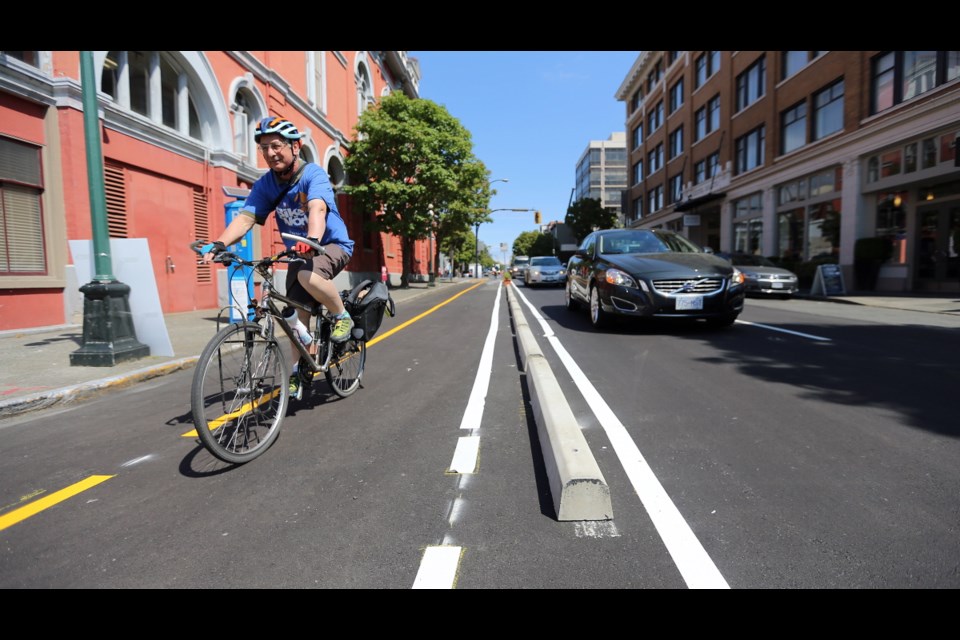Victoria is pumped to spend $7.75 million of its $9 million in gas tax reserves to create “the best small cycling city in the world,” says Mayor Lisa Helps.
Council is unanimously behind spending the federal money on the design and construction of protected bike lanes on eight major routes by November 2018, she said. “We’re aiming to create a completely connected network.”
She said council has been working on the vision, dubbed “Biketoria,” since it was elected a year ago.
This year, Victoria’s share of federal gas tax funding was $3.2 million.
“It’s about creating a city where everybody, no matter what their age and ability, can get around in a very low-barrier way,” she said.
Even older people who drive might be willing to cycle if they are physically separated from vehicle lanes, she said. “It’s good for cars, it’s good for bikes and it’s good for pedestrians.”
The city is seeking public input into the options under consideration, which will mean a decrease in some car parking spaces but increased bike parking, she said.
“It’s exceedingly exciting — we’ve set a bold ambitious goal,” said Helps, a life-long cyclist. She is eager to get started but noted that construction won’t begin until downtown businesses have come through the holiday season.
Pandora Avenue will be the first corridor to be tackled.
“Certainly businesses along Pandora have been very supportive,” she said, citing Habit Coffee, where 12 bicycles can be parked in the same space as a single vehicle. “You actually get more customers in front of your shop when they bike there rather than when they drive.”
Council and consultants from as far as Colombia, Copenhagen and Portland need to know if the right eight corridors have been chosen, Helps said. There are four east-west and four north-south routes.
The north-south corridors are:
• Harbour Road, Wharf Street and Belleville Street
• Government Street and Gorge Road
• Cook, Graham and Fifth streets
• Begbie and Shelbourne streets
The east-west corridors:
• Pandora and Oak Bay avenues
• Humboldt Street, Fairfield Road
• Fort Street
• Haultain Street, Bay Street and Kings Road
The proposed corridors were presented to a council committee last month and may be re-aligned based on public feedback received through consultation activities and design work.
“The corridor network is meant to encourage more people to cycle more often, while minimizing impacts to transit, motorists, and parking,” said city spokeswoman Michelle Harris.
City councillors will get an update at a Dec. 3 committee meeting, with the final design expected to be approved by council in early 2016, Harris said.
Ken Kelly, general manager of the Downtown Victoria Business Association, appreciated the idea of cycling strategies designed to involve the entire community with several options under consideration for each roadway. But the DVBA has not taken a position on the overall plan, he said. The DVBA board will be meeting with both the Government Street precinct and the Clean, Safe and Sustainable committee about the issue, he said.
There is “undeniably a need” for more bicycle parking downtown, Kelly said.
Even though the plan is still in an interim stage, it sounds “fantastic,” said Ray Straatsma, spokesman for the Greater Victoria Cycling Coalition.
There are no protected cycling lanes in the region at this point, something that he said is “one of the really great” things about what is being proposed.
“It’s a big advance over what we’ve seen in the past,” he said.
Such lanes provide total clarity as to where cyclists can ride safely and comfortably, and benefit users of all ages.
“Victoria has been a leader in the past and for a little while fell behind,” he said, even though commuting ridership alone approaches 10 per cent. Part of that is because Victoria is compact — only 20 square kilometres — and has “co-operative weather.” But cities such as Calgary, Montreal and Minneapolis have broken into their own when it come to cycling.
Victoria’s proposals provide welcome change in two ways, Straatsma said — a complete cycling network and protected lanes.
The more safety can be built into city cycling, the more ridership increases among timid bike owners and first-time cyclists, he said.
For more information and a survey on the proposed corridors, go to victoria.ca/cycling.
First protected lane to be built on Pandora
Cyclists cruising downtown on Pandora Avenue find the white painted lines of the bicycle lane disappear abruptly at Cook Street — but not for long.
The City of Victoria plans to build eight protected cycling corridors on major streets under a $7.75-million plan slated to start early in 2016.
First up for the planned bike network is a two-way protected cycling lane on Pandora, the first of its kind in the city.
The plan calls for the lane to be built on the north side of Pandora between Cook and Store streets. It will be separated from motor vehicle traffic by parked cars, bollards or planters. At some intersections, cyclists could have their own traffic signals.
Right-hand turns by vehicles will likely be accommodated via a turning lane, said city spokeswoman Michelle Harris. The details are being considered as the city goes through the design process for the cycling lanes.
“Minimal impact to existing parking is expected,” Harris said, noting that plans call for parking on both sides of the street, except along Harris Green, where parking will be permitted only on the north side of the street.
There will be at least two vehicle lanes along Pandora and transit stops will stay on the north side, she said.
“Detailed designs are being developed and have not been approved by council,” Harris said.



